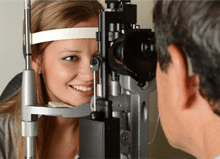We often get asked how to correct vision for distance and near in contact lenses. Whilst this can turn into a very complex subject we will give a brief explanation here to help you ask the right questions to your optician if you are wanting clear distance and reading vision in your lenses, or if you wear bifocal, varifocal or single-vision reading glasses and are interested in contact lenses.
Ignoring the various different types of contact lens material and disposability, this explanation will loosely work for all lens types.
There are three main options for correction;
- Multifocal lenses
- Monovision
- and (as silly as it sounds) single-vision distance lenses with ready-reading glasses over the top
Starting with the single-vision distance lenses, the distance vision in these should be better than the other two options, but you would have to wear over-the-counter reading glasses over the top of these lenses to gain the required reading vision. This technique usually gives the best all-round vision, but with the inconvenience of wearing contact lenses and spectacles simultaneously.
The next option is multifocal contact lenses. These are not to be confused with multifocal/bifocal spectacles as they look and work differently.
The idea with these is that you should be able to see in the distance and near to a fairly high standard, but for this benefit, you would usually pay a little more and may not have as wide a range of lenses to choose from.
The way these lenses work is if you imagine you are looking at a fried egg, you have the yoke in the middle and the white around the outside, well, in this example the reading component of the lens is the yoke, with the distance being the white. The pupils change size during different visual tasks, so when reading, the pupils shrink, locking on to the reading portion of the lens and when looking in the distance the pupils dilate and lock on to the distance portion of the lens. This lens option is very popular and can be very beneficial if you lead an active lifestyle and are looking for convenience to your vision.
Monovision contact lenses
The final option is called monovision and involves fitting a distance vision contact lens to your dominant eye and reading prescription lens to your non-dominant eye (don’t worry if you don’t know which is which, your optician will easily be able to define dominance).
Now, this technique always sounds like it won’t work, but with the correct introduction of prescription for reading it should work in almost every single case.
The advantage of this technique is that it typically doesn’t cost any more than normal contact lenses and the prescription can easily be modified over time to match prescription changes you may encounter.
This, as I said earlier, is only a brief outline of the options available, and your optician will need to carry out a series of tests and discuss what you are looking for in order to establish the best option for you.
But the important message is that almost everyone should be able to wear contact lenses to suit their lifestyle and vision requirements.
With this in mind, if the thought of contact lenses interests you then you really should get in touch with your local optometrist and book an appointment to see how your vision and lifestyle can be improved.
You won’t regret it!





